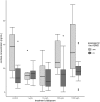Impact of the antidepressant citalopram on the behaviour of two different life stages of brown trout
- PMID: 32201650
- PMCID: PMC7073243
- DOI: 10.7717/peerj.8765
Impact of the antidepressant citalopram on the behaviour of two different life stages of brown trout
Abstract
Background: Over the last two decades, there has been a constant increase in prescription rates of antidepressants. In parallel, neuroactive pharmaceuticals are making their way into aquatic environments at increasing concentrations. Among the antidepressants detected in the environment citalopram, a selective serotonin reuptake inhibitor, is one of the most commonly found. Given citalopram is specifically designed to alter mood and behaviour in humans, there is growing concern it can adversely affect the behaviour on non-target wildlife.
Methods: In our study, brown trout were exposed to citalopram (nominal concentrations: 1, 10, 100, 1000 µg/L) in two different life stages. Larvae were exposed at 7 and 11 °C from the eyed ova stage until 8 weeks post yolk sac consumption, and juvenile brown trout were exposed for 4 weeks at 7 °C. At both stages we measured mortality, weight, length, tissue citalopram concentration, behaviour during exposure and behaviour in a stressfull environment. For brown trout larvae additionally hatching rate and heart rate, and for juvenile brown trout the tissue cortisol concentration were assessed.
Results: During the exposure, both larvae and juvenile fish exposed to the highest test concentration of citalopram (1 mg/L) had higher swimming activity and spent longer in the upper part of the aquaria compared to control fish, which is an indicator for decreased anxiety. Most probably due to the higher swimming activity during the exposure, the juveniles and larvae exposed to 1 mg/L citalopram showed decreased weight and length. Additionally, in a stressful artificial swimming measurement device, brown trout larvae displayed the anxiolytic effect of the antidepressant by reduced swimming activity during this stress situation, already at concentrations of 100 µg/L citalopram. Chemical analysis of the tissue revealed rising citalopram tissue concentrations with rising exposure concentrations. Tissue concentrations were 10 times higher in juvenile fish compared to brown trout larvae. Fish plasma concentrations were calculated, which exceeded human therapeutic levels for the highest exposure concentration, matching the behavioural results. Developmental parameters like hatching rate and heart rate, as well as mortality and tissue cortisol content were unaffected by the antidepressant. Overall, we could trace the pharmacological mode of action of the antidepressant citalopram in the non-target organism brown trout in two different life stages.
Keywords: Antidepressant; Behaviour; Brown trout; Citalopram; Corisol; Fish; Pharmaceutical; Stress hormone.
©2020 Ziegler et al.
Conflict of interest statement
The authors declare there are no competing interests.
Figures


Similar articles
-
Effects of the Antidepressant Amitriptyline on Juvenile Brown Trout and Their Modulation by Microplastics.Toxics. 2022 Dec 7;10(12):763. doi: 10.3390/toxics10120763. Toxics. 2022. PMID: 36548596 Free PMC article.
-
Does the antidiabetic drug metformin affect embryo development and the health of brown trout (Salmo trutta f. fario)?Environ Sci Eur. 2018;30(1):48. doi: 10.1186/s12302-018-0179-4. Epub 2018 Dec 7. Environ Sci Eur. 2018. PMID: 30595998 Free PMC article.
-
Impact of the NSAID diclofenac on survival, development, behaviour and health of embryonic and juvenile stages of brown trout, Salmo trutta f. fario.Sci Total Environ. 2017 Dec 31;607-608:1026-1036. doi: 10.1016/j.scitotenv.2017.07.042. Epub 2017 Jul 27. Sci Total Environ. 2017. PMID: 28724221
-
Climate and land-use changes affecting river sediment and brown trout in alpine countries--a review.Environ Sci Pollut Res Int. 2009 Mar;16(2):232-42. doi: 10.1007/s11356-008-0075-3. Epub 2008 Dec 2. Environ Sci Pollut Res Int. 2009. PMID: 19048320 Review.
-
[Escitalopram: a selective inhibitor and allosteric modulator of the serotonin transporter].Encephale. 2007 Dec;33(6):965-72. doi: 10.1016/j.encep.2007.11.001. Epub 2007 Dec 11. Encephale. 2007. PMID: 18789789 Review. French.
Cited by
-
Effects of the Antidepressant Amitriptyline on Juvenile Brown Trout and Their Modulation by Microplastics.Toxics. 2022 Dec 7;10(12):763. doi: 10.3390/toxics10120763. Toxics. 2022. PMID: 36548596 Free PMC article.
-
Distribution of two isoforms of tryptophan hydroxylase in the brain of rainbow trout (Oncorhynchus mykiss). An in situ hybridization study.Brain Struct Funct. 2021 Sep;226(7):2265-2278. doi: 10.1007/s00429-021-02322-8. Epub 2021 Jul 2. Brain Struct Funct. 2021. PMID: 34213591 Free PMC article.
-
Investigation of the Aquatic Photolytic and Photocatalytic Degradation of Citalopram.Molecules. 2021 Sep 2;26(17):5331. doi: 10.3390/molecules26175331. Molecules. 2021. PMID: 34500774 Free PMC article.
-
Pharmaceutical pollution disrupts the behavior and predator-prey interactions of two widespread aquatic insects.iScience. 2022 Nov 25;25(12):105672. doi: 10.1016/j.isci.2022.105672. eCollection 2022 Dec 22. iScience. 2022. PMID: 36536674 Free PMC article.
-
Computational Modelling and Sustainable Synthesis of a Highly Selective Electrochemical MIP-Based Sensor for Citalopram Detection.Molecules. 2022 May 21;27(10):3315. doi: 10.3390/molecules27103315. Molecules. 2022. PMID: 35630794 Free PMC article.
References
-
- Acuna V, Von Schiller D, Garcia-Galan MJ, Rodriguez-Mozaz S, Corominas L, Petrovic M, Poch M, Barcelo D, Sabater S. Occurrence and in-stream attenuation of wastewater-derived pharmaceuticals in Iberian rivers. Science of the Total Environment. 2015;503–504:133–141. doi: 10.1016/j.scitotenv.2014.05.067. - DOI - PubMed
-
- Alvarez-Munoz D, Rodriguez-Mozaz S, Maulvault AL, Tediosi A, Fernandez-Tejedor M, Van den Heuvel F, Kotterman M, Marques A, Barcelo D. Occurrence of pharmaceuticals and endocrine disrupting compounds in macroalgaes, bivalves, and fish from coastal areas in Europe. Environmental Research. 2015;143:56–64. doi: 10.1016/j.envres.2015.09.018. - DOI - PubMed
-
- aus der Beek T, Grüttner G, Carius A. Pharmaceuticals in the environment: global occurence and potential cooperative action under the Strategic Appoach to International Chemicals Management (SAICM), Agency GE, editor. German Environment Agency; Dessau-Roßlau: 2016.
-
- Demin KA, Kolesnikova TO, Khatsko SL, Meshalkina DA, Efimova EV, Morzherin YY, Kalueff AV. Acute effects of amitriptyline on adult zebrafish: potential relevance to antidepressant drug screening and modeling human toxidromes. Neurotoxicology and Teratology. 2017;62:27–33. doi: 10.1016/j.ntt.2017.04.002. - DOI - PubMed
LinkOut - more resources
Full Text Sources

